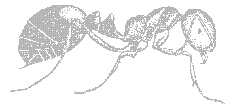
|  |
Fire ants are reddish-brown in color. They are small( 1 /16 to 1 /4 inch long) and have a painful sting that produces a white bump within 8 to 24 hours. Fire ants make mounds and their painful stings are a health threat. Fire ants nest near homes and buildings and can cause problems when they search indoors for food and moisture. They also enter air conditioners and other electrical equipment where they can damage fuses and wiring.
Many products are available for controlling fire ants.Most work well when used correctly. It is helpful to know the advantages and limitations of the products.
The two-step method of fire ant controlThe two-step method can control fire ants when followed once or twice a year. The first step is to spread a bait insecticide over the entire yard. At least three commercially available fire ant baits can be applied in this way: Amdro ® , Award ® and PT 370 Ascend ® . The best times for applying baits are spring and fall, although you can apply them anytime during the warm season when ants are active.
The second step is to treat each mound with an approved insecticide, such as a mound drench,granular or dust. Apply the insecticide no sooner than 3 days after you apply baits. Treat only the mounds that are causing immediate problems.Most mounds that receive only the bait treatment disappear in time. Leave any mounds that are not killed because they may keep other ants from returning. Here are a few tips on how to use bait sand individual mound treatments most effectively. Remember it is very important always to follow the directions on the label.
Step one: BaitsUse fresh bait from an unopened or tightly sealed container that has been stored less than 2 years. Apply when the ground and grass are dry and no rain is expected for the next 24 hours.
Apply when worker ants are searching for food. To find this out, leave a small pile of bait next to an active mound. If ants remove the bait within 10 to 30minutes, begin treatment. Ants are less active during cold and hot periods (when soil temperature is less than 70 degrees F or greater than 95 degrees F).
In the summer, apply bait in late afternoon or evening when ants are most active. Baits can be applied by hand if you use protective gloves. Spread small amounts over the entire area (about 1 /2 - 3 /4cup of bait per 5,000 square feet). Bait products contain different active ingredients that work in unique ways. Amdro ® is a slow-acting poison that causes approximately 80 to 90 percent of the mounds in a treated area to become inactive within 1 to 5weeks. Award ® keeps queen ants from producing more workers. It may take 5 to 10 weeks or more to see the results, but as many as 90 percent of the mounds may be eliminated. Control may last up to a year.
Step two: Individual mound treatmentsThere are both chemical and non-chemical methods for treating fire ant mounds one at a time: chemical treatments and non-chemical treatments.
Chemical treatmentsSome products are formulated as dusts. Ants walk on the ground and get dust on their bodies and carry the insecticide into the mound. The entire colony should be killed within a few days. To use a dust, spread the recommended amount evenly over the mound. Do not inhale the dust or get it on your skin.
Some chemical products are liquid concentrates that can be diluted with water and then applied to the mound. These liquid mound drenches kill the ants underground. Enough liquid must be applied to penetrate the entire nest (1 - 2 gallons of diluted mixture). Mound drenches generally get rid of mounds within a few hours. When handling liquid concentrates avoid getting the product on your skin by always wearing rubber gloves. Mix the proper amount in a 1- or 2- gallon container. Write "Poison"on the container and do not use it for any other purpose.
Granular products offer another method of getting insecticide into fire ant mounds. The active ingredient in a granular insecticide is released when water is poured over the granules. To treat a single mound, measure the recommended amount in a measuring cup and sprinkle it on top of, and around the mound. Sprinkle water over the treated mound.Do it gently to avoid disturbing the colony and washing the granules off the mound.
Remember, you need to apply the recommended amount of water (1 - 2 gallons) with liquid concentrates and granular insecticides to get good results. The product must completely invade the mound or ants will move to a different site through the underground to avoid the poison.
Non-chemical treatmentsBoiling water (about 3 gallons per mound) will eliminate about 60 percent of the mounds treated,but this treatment can be hazardous for the person carrying the water. Be careful not to pour boiling water on grass or other plants. Individual mounds can be moved from problem areas, such as gardens,by shoveling the mounds into a bucket. Sprinkle talcum powder liberally on the inside of the bucket and on the shovel handle to prevent ants from traveling up the handle and stinging you.
Do not use gasoline or other petroleum products for fire ant control. While many of these materials will kill fire ants, they are flammable, will kill grass and other plants around treated mounds and can pollute the environment.
THE TWO-STEP METHOD |
|
| STEP 1: Baits | |
| Advantages: | Disadvantages: |
|
|
| STEP 2: Mound Treatments | |
| DUSTS | |
| Advantages: | Disadvantages: |
|
|
| LIQUID DRENCHES | |
| Advantages:: | Disadvantages: |
|
|
| GRANULAR MOUND TREATMENTS | |
| Advantages: | Disadvantages: |
|
|
| BAITS | |
| Advantages: | Disadvantages: |
|
|
The information given herein is for educational purposes only. Reference to commercial products or trade names is made with the understanding that no discrimination is intended and no endorsement by the Cooperative Extension Service is implied.
|
Texas Agricultural Extension Service
|
Adapted from TAEX publication L-507 0 The Two-Step MethodDo-It-Yourself Fire Ant Control for your use by Ana A. DeLuna,Extension Assistant in Communications. Graphic design byRhonda R. Kappler.
Una Vida Mejor project activities are supported by a grantfrom the W. K. Kellogg Foundation.
Educational programs conducted by the Texas AgriculturalExtension Service serve people of all ages regardless of socio-economiclevel, race, color, sex, religion, disability, or national rigin.
Disclaimer and Reproduction Information: Information in NASD does not represent NIOSH policy. Information included in NASD appears by permission of the author and/or copyright holder. More